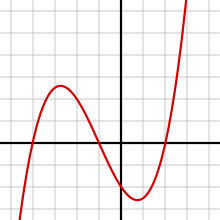
In mathematics, a differentiable function of one real variable is a function whose derivative exists at each point in its domain. In other words, the graph of a differentiable function has a non-vertical tangent line at each interior point in its domain. A differentiable function is smooth (the function is locally well approximated as a linear function at each interior point) and does not contain any break, angle, or cusp.
If x0 is an interior point in the domain of a function f, then f is said to be differentiable at x0 if the derivative exists. In other words, the graph of f has a non-vertical tangent line at the point (x0, f(x0)). f is said to be differentiable on U if it is differentiable at every point of U. f is said to be continuously differentiable if its derivative is also a continuous function over the domain of the function . Generally speaking, f is said to be of class if its first derivatives exist and are continuous over the domain of the function .
For a multivariable function, as shown here, the differentiability of it is something more complex than the existence of the partial derivatives of it.




